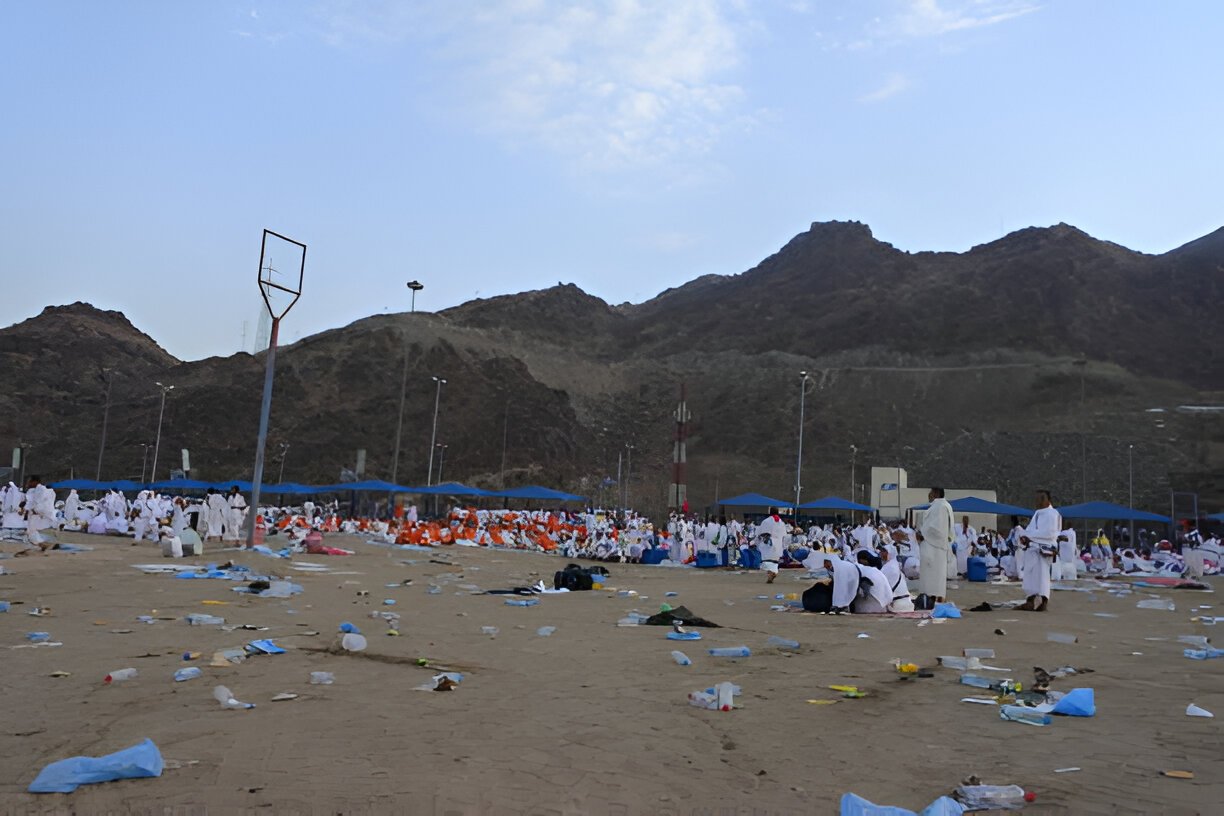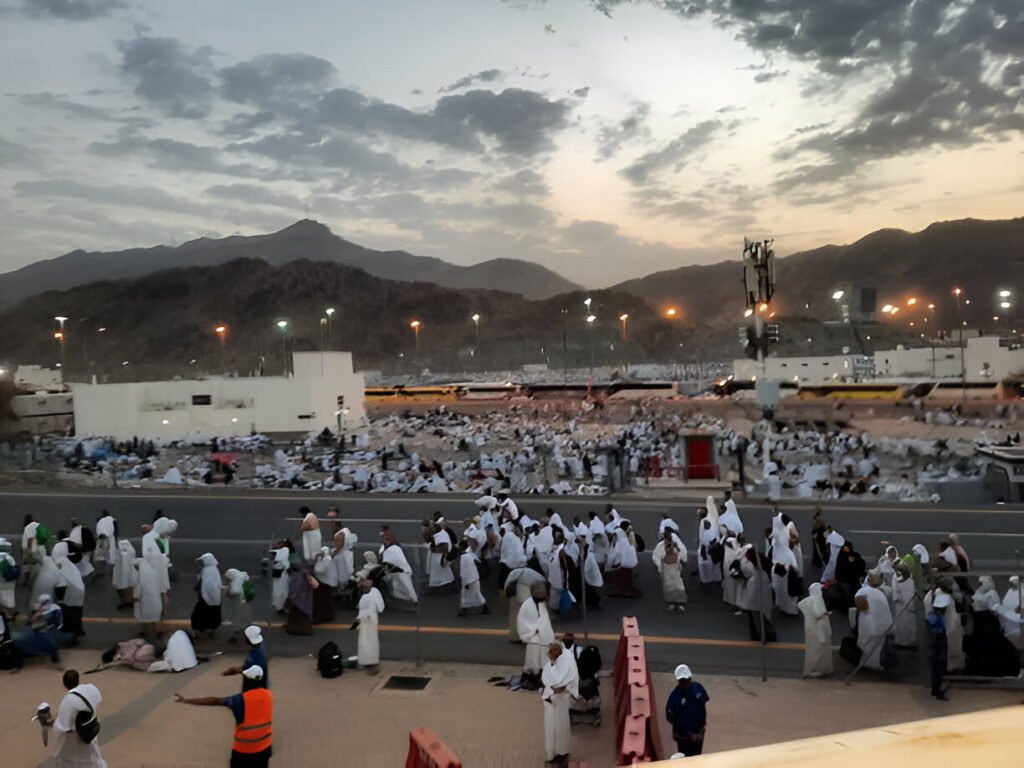Muzdalifah
Muzdalifah is the name of a place located between Mina and Arafat. After the pilgrims leave Arafat towards Mina after sunset on the 9th of Dhul-Hijjah, they spend the night here. Muzdalifah is essentially the name of a 4,370-meter-long area situated in the middle of the narrow path between two mountains, named Majamain, which leads to Arafat, and the middle of the valleys of Madik and Mohassar.
Origin of the Name Muzdalifah
There are several opinions about the origin of the name Muzdalifah. They are: (1) The word Muzdalifah originates from the word “Ezdalaf,” which means to come near. Since all the pilgrims gather here, they become close to each other; hence it is called Muzdalifah. (2) It is called Muzdalifah because the pilgrims become close to Allah by staying here. (3) The word Ezdalaf means to unite or gather. People gather here, so it is called Muzdalifah. (4) It is called Muzdalifah because, by the will of Allah, Hazrat Adam (AS) and Hazrat Hawa met here. (5) It is called Muzdalifah because the pilgrims combine the Maghrib and Isha prayers here.
Spending the Night at Muzdalifah
Spending the night at Muzdalifah is obligatory. According to Hazrat Ibn Umar, the entire Muzdalifah is Mash’arul Haram, so it is permissible to spend the night anywhere within it. Other scholars also agree that it is permissible to spend the night anywhere in Muzdalifah. This is because the Messenger of Allah (SAW) said, “The entire area of Muzdalifah is a place of stay.” However, they refer to the middle area of Muzdalifah, called the “Kozah” mountain, as Mash’arul Haram. They consider staying and spending the night in this place, remembering Allah, offering gratitude, and worshipping to be recommended. It is narrated in authentic Hadith that the Messenger of Allah (SAW) spent the night here. It is best to stay in this area following the example of the Messenger of Allah (SAW). After the Fajr prayer at the current mosque location in Muzdalifah, the Messenger of Allah (SAW) was busy in supplication and remembrance and continued until just before the sky lightened at dawn. According to many, the entire Muzdalifah is Mash’arul Haram.
Allah says in the Qur’an:
فإِذَا أَفَضْتُمْ مِّنْ عَرَفَاتِ فَاذْكُرُوا اللهَ عِنْدَ الْمَشْعَرِ الحَرَامِ وَاذْكُرُوهُ
كَمَا هَدَاكُمْهَدَاكُمْ (Al-Baqarah: 198)
Translation: “And when you depart from Arafat, remember Allah near the Mash’arul Haram, and remember Him as He has guided you.” Mash’arul Haram means a designated place for worship.
Prayers at Muzdalifah
It is narrated in Muslim Sharif from Hazrat Jabir bin Abdullah (RA) that when the Messenger of Allah (SAW) arrived in Muzdalifah, he performed the Maghrib and Isha prayers together with a single Adhan and two Iqamas.
He did not pray any Sunnah between the two prayers, nor did he perform any voluntary worship. This indicates that abandoning the Sunnah and voluntary prayers at Muzdalifah is the Sunnah, as the Messenger of Allah (SAW) did not perform them. However, the Witr prayer must be performed. After this, he had his meal and went to sleep. This proves that sleeping in Muzdalifah is Sunnah. Through this, he fulfilled his bodily needs and left a special lesson for his Ummah. He got up before Subh-e-Sadiq and performed the Fajr prayer at its earliest time so that there would be more time for supplication and glorification. He then mounted his camel, Qaswah, and went to Mash’arul Haram while reciting Takbir and declaring the Oneness of Allah. He instructed Fadhal bin Abbas (RA) to collect pebbles from Muzdalifah for throwing at the Jamrah Aqabah.
 The night stay at Muzdalifah
The night stay at Muzdalifah
There is a difference of opinion among scholars regarding the night stay at Muzdalifah. According to Hazrat Umar (RA), the time for the night stay at Muzdalifah is from Subh-e-Sadiq until just before sunrise. Amr bin Maymun narrates that Hazrat Umar (RA) performed the Fajr prayer at Muzdalifah, then stayed there and said, “The polytheists never left Muzdalifah before sunrise.” But the Messenger of Allah (SAW) opposed this practice and left Muzdalifah before sunrise. Ahmad and Abu Dawood
According to Imam Abu Hanifa and other scholars, the time for staying in Muzdalifah is from Subh-e-Sadiq until just before sunrise. If someone does not stay during this time without a valid excuse, they must offer a compensatory sacrifice. Anyone who stays in Muzdalifah during this time will fulfill the duty of staying, whether they spend the night or not. Staying at Muzdalifah during this time is obligatory, while spending the night there is a Sunnah.
According to Imam Shafi’i and Imam Ahmad, staying in Muzdalifah after midnight is valid, and if someone leaves Muzdalifah before midnight, they must offer a compensatory sacrifice. However, according to Imam Malik, it is permissible to leave Muzdalifah after performing Maghrib and Isha prayers, having eaten, and before sunrise. According to the Maliki school, only those who provide water and shepherds are exempt from spending the night at Muzdalifah. This is because the Messenger of Allah (SAW) had granted permission for these two groups.
According to Imam Ahmad and Imam Shafi’i, staying in Muzdalifah after midnight is obligatory. If someone stays for some time during that period, they will have fulfilled their obligation. On the other hand, in the Hanafi school, staying at Muzdalifah for the night is a confirmed Sunnah, and staying in Muzdalifah from Subh-e-Sadiq until just before sunrise is obligatory.
For those who have an excuse, the Messenger of Allah (SAW) did not instruct them to stay the night at Muzdalifah or to stay from Subh-e-Sadiq until sunrise. When those who were looking after the water or the shepherds came to ask for permission, he allowed them to leave Muzdalifah. Similarly, he gave permission for women and children to leave Muzdalifah. Hazrat Ibn Abbas (RA) narrates that the Messenger of Allah (SAW) sent some young boys from the family of Abd al-Muttalib to leave Muzdalifah before dawn. He gently patted them and said, “My children, do not throw pebbles at the Jamrah until sunrise.”
It is narrated from Hazrat Aisha (RA) that when they reached Muzdalifah, Sawda bint Zam’a asked for permission to leave ahead of the crowd. She was slow, so she left before the others. After spending the night at Muzdalifah, they left later. Another narration from Hazrat Aisha mentions that the Messenger of Allah (SAW) sent Hazrat Umm Salma to leave Muzdalifah before Subh-e-Sadiq. That night, it was her turn to stay with the Messenger of Allah (SAW). From Ummul Mu’minin Umm Habiba bint Abi Sufyan, it is narrated that the Messenger of Allah (SAW) sent her to leave Muzdalifah before the night ended. It is also narrated by Asma bint Abi Bakr, the wife of Zubair, that she threw pebbles at the Jamrah during the night. She also said, “We used to do the same during the time of the Messenger of Allah (SAW).” Talha bin Zubair and Abdullah bin Umar (RA) would send the weaker people, women, and children from Muzdalifah to Mina during the night.
In conclusion, it is permissible to send people with excuses, the weak, and those who are ill or frail to leave Muzdalifah before dawn.
Sunnah of Staying at Muzdalifah
There are six Sunnahs related to staying at Muzdalifah. They are: (1) taking a bath after midnight, and if water is not available, performing tayammum. (2) Performing the Fajr prayer at the first time so that there is more time for the stay. (3) Upon arrival at Mash’arul Haram, facing the Qiblah and making supplication. (4) According to the Hanafi, Shafi’i, and Hanbali schools, and most scholars, it is Sunnah to leave Muzdalifah just before sunrise. According to Imam Malik, it is permissible to leave before the sky lightens. (5) Walking slowly from Muzdalifah to Mina. Only in the Mohassir valley should walking be fast. Ibn Abbas (RA) narrates that the Messenger of Allah (SAW) asked Fadl bin Abbas to ride behind him and said, “O people, there is no virtue in making camels or horses race. Walk slowly.” The Messenger of Allah (SAW) remained steady until reaching Mina. (6) Walking quickly through the Mohassir valley, whether on foot, riding, or in a vehicle. In all cases, it should be passed quickly. It is narrated in Nasa’i that Hazrat Jabir (RA) said that the Messenger of Allah (SAW) passed through the Mohassir valley quickly.
The mosque built in Mash’arul Haram previously had only one minaret. During the Saudi era, a beautiful mosque was constructed with two minarets. The area of the mosque is 5,400 square meters, and it can accommodate up to 200,000 worshipers. To meet the water needs of pilgrims staying at Muzdalifah, a metal reservoir capable of holding 50,000 cubic meters of water has been built in the nearby mountain. Additionally, the mosque’s reservoir holds 2,000 cubic meters of water, and several toilets have been built.
Additionally, all the roads in Muzdalifah for both vehicles and pedestrians have been paved, and eight roads from Muzdalifah to Arafat have been constructed. A bridge, named King Faisal Overpass, has also been built in the middle of Muzdalifah. Recently, for the convenience of pilgrims, necessary water supply, reservoir construction, and sewage systems, as well as 2,000 toilets, have been installed.
Leaving Muzdalifah
Just before dawn, when the sky lightened, the Messenger of Allah (SAW) departed from Muzdalifah and walked quickly to the Mohassar valley. The road that the Messenger of Allah (SAW) took from Muzdalifah to Mina is now known as “Sokul Arab.” Before this, he had traveled through the road called “Dabb” from Mina to Arafat. The habit of the Messenger of Allah (SAW) was to travel along one road and return via another. He then stopped at the tree near the Jamrah Aqabah and threw seven pebbles at the large Jamrah a little after sunrise. With each stone thrown, he declared Takbir and then proceeded to the place of sacrifice. Among the 100 camels brought for sacrifice, he himself sacrificed 63 and instructed Hazrat Ali (RA) to sacrifice the remaining ones. Then he ate the meat of the sacrifice.
During the time of Jahiliyyah, people would depart from Muzdalifah after sunrise and say, “The light has appeared from the Sabir mountain; let us set off.” The Messenger of Allah (SAW) opposed this custom of the Jahiliyyah and left Muzdalifah just before sunrise.
In Jahiliyyah, when people arrived at Muzdalifah from Arafat, they would light fires so that they could find their way and not get lost. It is narrated that when the Messenger of Allah (SAW) arrived in Muzdalifah, fires were lit there. He stopped near one of those fires.



